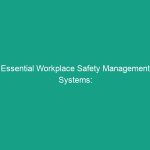Good morning team!
Today, we’re going to talk about an essential aspect of our work Environment: crowd control at work sites. Managing public access safely is not just a regulatory requirement; it is crucial for the Safety of everyone involved—our employees, visitors, and the general public. Effective crowd control can prevent accidents, ensure smooth operations, and foster a safer workplace.
Understanding Crowd Control at Work Sites
Crowd control refers to the methods and strategies used to manage a group of people at work sites, particularly in areas where public access is allowed. This includes directing individuals, ensuring their Safety, and preventing unauthorized access to Hazardous Areas. The importance of crowd control cannot be overstated; a well-managed crowd minimizes the risk of accidents and enhances operational efficiency.
Many might think that crowd control is only necessary during large events or emergency situations, but it is a daily necessity at work sites. Misunderstanding this can lead to serious safety incidents, injuries, and even fatalities. Therefore, it’s essential to recognize that every employee plays a part in maintaining safety.
Key Hazards, Risks, and Safety Considerations
When it comes to crowd control, there are several Hazards and risks that we need to be aware of:
- Unauthorized Access: Visitors or unauthorized personnel entering restricted areas can lead to accidents.
- Overcrowding: Too many people in one area can create panic or impede emergency evacuations.
- Communication Breakdowns: Lack of proper signage and instructions can result in confusion among the crowd.
- Environmental Hazards: Work sites often have physical hazards—like machinery and materials—that can pose risks to unwary individuals.
Real-world consequences of ignoring these hazards can be severe. For instance, a construction site that fails to manage public access may see an increase in injuries, legal liabilities, and damage to equipment. Our goal is to prevent these outcomes by implementing effective crowd Control Measures.
Best Practices, Procedures, & Actionable Advice
To manage crowd control effectively at our work sites, consider the following Best Practices:
1. Establish Clear Boundaries
Use barriers, ropes, or fencing to create clear boundaries between work areas and public access zones. This helps to minimize unauthorized access and directs the flow of people safely.
2. Use Signage Effectively
Post clear, visible signs indicating restricted areas, safety instructions, and emergency exits. Ensure that the signage is easily understandable and visible from various angles.
3. Train Employees on Crowd Management
Provide Training sessions for all employees on crowd control Procedures. Employees should know how to direct visitors, handle large groups, and respond to emergencies.
4. Monitor Crowds Regularly
Assign personnel to monitor the crowd and ensure compliance with Safety Measures. They should be easily identifiable and equipped to handle any issues that arise.
5. Implement Emergency Plans
Have clear emergency plans in place for crowd evacuations. Regularly practice these plans through drills so everyone knows what to do in case of an emergency.
Case Study: Real-World Incident
Consider the incident at a local construction site last year, where a lack of crowd control led to an injured visitor who wandered into a hazardous area. This not only resulted in injury but also caused significant financial loss and damage to the company’s reputation. This case highlights the critical need for effective crowd Control Measures.
Regulations, Standards, and Compliance
It’s important to comply with relevant safety Regulations, such as those set by OSHA and local authorities. These regulations often require specific measures for crowd control and Public Safety. Compliance is not just about avoiding fines; it’s about ensuring the safety of everyone on site.
Understanding these regulations will help us build a safer work environment. Regular audits and training can ensure our compliance and keep everyone informed about Best Practices.
Employee Engagement & Discussion
Now that we’ve covered the essentials, let’s open the floor for discussion. Here are a few questions to consider:
- What safety challenges have you encountered related to crowd control at work sites?
- Can you share any experiences where effective crowd management made a difference?
- What additional measures do you think we could implement to improve safety?
Your input is valuable and can lead to improved Safety Measures for all of us!
Conclusion & Key Takeaways
In summary, effective crowd control at work sites is essential for ensuring public safety and protecting our employees. By establishing clear boundaries, using signage, providing training, monitoring crowds, and implementing emergency plans, we can create a safer work environment.
Remember, safety is a shared responsibility, and your active participation is crucial. Let’s all commit to prioritizing safety and making our work sites as safe as possible.
Thank you all for your attention and dedication to safety. Together, we can make a significant difference!


